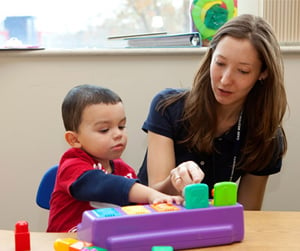 Everyday activities can be opportunities to expand learning – particularly for speech and language. Here are seven easy, familiar options you can do at home with your child that offer speech and language cues. Encourage the child to repeat words or anticipate the next word or sentence. For example, after we put on our socks, what comes next? Shoes.
Everyday activities can be opportunities to expand learning – particularly for speech and language. Here are seven easy, familiar options you can do at home with your child that offer speech and language cues. Encourage the child to repeat words or anticipate the next word or sentence. For example, after we put on our socks, what comes next? Shoes.
If your child vocalizes to you but you are unsure of what they are trying to say - take a guess! “Are you asking for milk?” By showing that you are actively listening, the child understands that what he/she has to say is important and interesting to you – and encourages them to talk more.
Try to limit commands or directives, such as “say ball” – let the child engage in dialogue with you, while you show enthusiasm for their attempts. “Yes! Good job!”
1. At bath time, pretend to put the child into the bathtub with their clothes on.
Besides words, this little game also helps a child understand the sequence of things - clothes come off before a bath.
"Are you ready for a bath? Oops! Something is not right! First we need to take off your shirt...OK, shirt off...ready now?
Oops... nope...next we need to take off your pants...ready now?
Oops...no... next we need to take off your socks... one sock , two socks…
Now you’re ready for a bath!”
2. Most families have “assigned seats” at the dinner table. Purposefully sit in the “wrong” chair.
Children often notice when something seems out of place or break in a pattern. Playing a game that is reminiscent of the Three Bears story, you move around the table to sit in the “wrong” chairs, announcing: “this my chair, my spot -oops...no, wait...I sit here!... No? Oh, this is Charlies spot…wait, is this my chair? No? Aha, this is my chair!” Which chair is yours?
3. Line up a row of family members’ shoes …
Repetition of words, even when the objects are visually different, help a child understand that words can cover a variety of similar objects.
“Let’s put your shoes on... Are these your shoes?...nope, too big – are they Mommy's shoes? Are these your shoes?...nope, too big –are they Daddy’s shoes?
I’ll put my shoes on. (Pretend to put on the child's shoes.) These are NOT my shoes, my feet are too big, these shoes are too small for me, are they YOUR shoes ?”
4. An empty sippy cup…
Offering choices gives you the opportunity to expand vocabulary and gives the child some power in that they are allowed to make the choice.
Give the child an empty sippy cup, wait for them to protest that it's empty … "Uh-oh , oh my, is it empty? What do you want? Do you want milk or juice?
5. Look for opportunities that pop up on their own.
If your child is squirming in your arms and clearly wants down…"Oh - do you want down? Which way is down? Here we go, doooown (in a descending voice). Same with “up”.
The child wants to go outside… “I see the sun is shining, why don’t we go for a walk? We will need our jackets to go for a walk. We will need to put on our shoes to go for a walk. Do you like to go for walks?”
6. Let’s count.
There are lots of daily opportunities to count, even if the child hasn’t learned how to count beyond a few numbers. Just hearing and seeing the method of counting will help him/her to build language and the concept of counting.
“Let’s count the stairs as we go up…1…2…3…”
“Let’s count the plates as we set the table…1…2…3…”
“Let’s count the balls in the toybox…1…2…3…”
7. Throughout the day, narrate what you are doing, as you do it. Keep speech focused on what is happening right now - in the moment.
“I see it is lunchtime. Let’s have sandwiches. I’ll get the bread…and peanut butter and jelly. I’ll need a knife to spread it on the bread. Now, I put it on the plate for you.”










